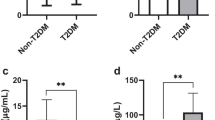Abstract
Several environmental and genetic factors are believed to influence the onset of diabetes and its complications. It has also been established that cytokines play a key role in the pathogenesis of type 2 diabetes. Previous studies have revealed that the polymorphism at the stromal-derived factor 1β (SDF-1β) 3′A regulates the expression of SDF-1 (CXCL12). This study was aimed to explore this polymorphism in parallel with SDF-1 serum levels in type 2 diabetic patients. In this assessment, peripheral blood samples were collected from 200 type 2 diabetic patients and 200 healthy controls. DNA was extracted, and a PCR-RFLP screening was applied to examine the SDF-1β 3′A polymorphism. We also applied the ELISA technique to measure serum levels of SDF-1. Our results showed that there were no significant correlations between SDF-1β 3′Α polymorphism in type 2 diabetic patients when compared to controls. However, our results showed that the serum levels of SDF-1 were significantly increased in the patients when compared to controls. Based on the results of this study, we concluded that SDF-1β 3′Α polymorphism does not play a role in the pathogenesis of type 2 diabetes but that elevated serum levels of SDF-1 may be important for the etiology of type 2 diabetes but are unrelated to the SDF-1β 3′Α polymorphism.

Similar content being viewed by others
References
Steyn, N.P., E.V. Lambert, and H. Tabana. 2009. Conference on “Multidisciplinary approaches to nutritional problems”. Symposium on “Diabetes and health”. Nutrition interventions for the prevention of type 2 diabetes. Proceedings of the Nutrition Society 68: 55–70.
Arababadi, M.K., Mirzaei, M., Sajadi, S.M.A., Hassanshahi, G., Ahmadababdi, B.N., Salehabadi, V.A., Derakhshan, R., Kennedy, D. 2011. Interleukin (IL)-10 gene polymorphisms are associated with type 2 diabetes with and without nephropathy: a study of patients from the South-East region of Iran. Inflammation (in press).
Olivares-Reyes, J.A., A. Arellano-Plancarte, and J.R. Castillo-Hernandez. 2009. Angiotensin II and the development of insulin resistance: implications for diabetes. Molecular and Cellular Endocrinology 302: 128–139.
Cruz, M., C. Maldonado-Bernal, R. Mondragon-Gonzalez, R. Sanchez-Barrera, N.H. Wacher, G. Carvajal-Sandoval, and J. Kumate. 2008. Glycine treatment decreases proinflammatory cytokines and increases interferon-gamma in patients with type 2 diabetes. Journal of Endocrinological Investigation 31: 694–699.
Giulietti, A., E. van Etten, L. Overbergh, K. Stoffels, R. Bouillon, and C. Mathieu. 2007. Monocytes from type 2 diabetic patients have a pro-inflammatory profile. 1,25-dihydroxyvitamin D(3) works as anti-inflammatory. Diabetes Research and Clinical Practice 77: 47–57.
Nathanson, D., and T. Nystrom. 2009. Hypoglycemic pharmacological treatment of type 2 diabetes: targeting the endothelium. Molecular and Cellular Endocrinology 297: 112–126.
Tsiavou, A., D. Degiannis, E. Hatziagelaki, K. Koniavitou, and S.A. Raptis. 2004. Intracellular IFN-gamma production and IL-12 serum levels in latent autoimmune diabetes of adults (LADA) and in type 2 diabetes. Journal of Interferon & Cytokine Research 24: 381–387.
Skopinski, P., E. Rogala, B. Duda-Krol, A. Lipinska, E. Sommer, J. Chorostowska-Wynimko, J. Szaflik, I. Partyka, and E. Skopinska-Rozewska. 2005. Increased interleukin-18 content and angiogenic activity of sera from diabetic (type 2) patients with background retinopathy. Journal of Diabetes and its Complications 19: 335–338.
Pickup, J.C., G.D. Chusney, S.M. Thomas, and D. Burt. 2000. Plasma interleukin-6, tumour necrosis factor alpha and blood cytokine production in type 2 diabetes. Life Sciences 67: 291–300.
Arababadi, M.K., R. Nosratabadi, G. Hassanshahi, N. Yaghini, V. Pooladvand, A. Shamsizadeh, H. Hakimi, and R. Derakhshan. 2009. Nephropathic complication of type-2 diabetes is following pattern of autoimmune diseases? Diabetes Research and Clinical Practice 87: 33–37.
Hassanshahi, G., S.S. Patel, A.A. Jafarzadeh, and A.J. Dickson. 2007. Expression of CXC chemokine IP-10/Mob-1 by primary hepatocytes following heat shock. Saudi Medical Journal 28: 514–518.
Hassanshahi, G., A. Jafarzadeh, and D.A. James. 2008. Expression of stromal derived factor alpha (SDF-1 alpha) by primary hepatocytes following isolation and heat shock stimulation. Iranian Journal of Allergy, Asthma, and Immunology 7: 61–68.
Daryani, A., A.Z. Hosseini, and A. Dalimi. 2003. Immune responses against excreted/secreted antigens of Toxoplasma gondii tachyzoites in the murine model. Veterinary Parasitology 113: 123–134.
Kimura, R., T. Nishioka, and T. Ishida. 2003. The SDF1-G801A polymorphism is not associated with SDF1 gene expression in Epstein-Barr virus-transformed lymphoblastoid cells. Genes and Immunity 4: 356–361.
Hassanshahi, G., M.K. Arababadi, H. Khoramdelazad, N. Yaghini, and E.R. Zarandi. 2010. Assessment of CXCL12 (SDF-1alpha) polymorphisms and its serum level in posttransfusion occult HBV-infected patients in Southeastern Iran. Archives of Medical Research 41: 338–342.
Alfadda, A.A., and M.A. Alzoghaibi. 2008. Circulatory neutrophil chemokines in statin-treated diabetic patients. Saudi Medical Journal 29: 584–588.
Yuen, M.F., C.K. Lee, D.K. Wong, J. Fung, I. Hung, A. Hsu, D.Y. But, T.K. Cheung, P. Chan, J.C. Yuen, F.K. Fung, W.K. Seto, C.K. Lin, and C.L. Lai. 2011. Prevalence of occult hepatitis B infection in a highly endemic area for chronic hepatitis B: a study of a large blood donor population. Gut 59: 1389–1393.
Ebrahimi, H., M. Soleimani, M. Kazemi Arababadi, N. Ahmadbeigi, G. Hassanshahi, A. Farjadfar, and D. Kennedy. 2010. An in vitro assay to evaluate the immunomodulatory effects of unrestricted somatic stem cells. Iranian Journal of Immunology 7: 30–38.
Sayyed, S.G., H. Hagele, O.P. Kulkarni, K. Endlich, S. Segerer, D. Eulberg, S. Klussmann, and H.J. Anders. 2009. Podocytes produce homeostatic chemokine stromal cell-derived factor-1/CXCL12, which contributes to glomerulosclerosis, podocyte loss and albuminuria in a mouse model of type 2 diabetes. Diabetologia 52: 2445–2454.
Acknowledgments
The authors of this article take this chance to thank all the diabetic patients and healthy controls who generously contributed to this research. In addition, we would like to thank all the staff working at the diabetes clinic of Ali-Ebn-Abitaleb Hospital for their warm cooperation and technical assistance.
Author information
Authors and Affiliations
Corresponding author
Rights and permissions
About this article
Cite this article
Derakhshan, R., Arababadi, M.K., Ahmadi, Z. et al. Increased Circulating Levels of SDF-1 (CXCL12) in Type 2 Diabetic Patients Are Correlated to Disease State but Are Unrelated to Polymorphism of the SDF-1β Gene in the Iranian Population. Inflammation 35, 900–904 (2012). https://doi.org/10.1007/s10753-011-9391-8
Published:
Issue Date:
DOI: https://doi.org/10.1007/s10753-011-9391-8




